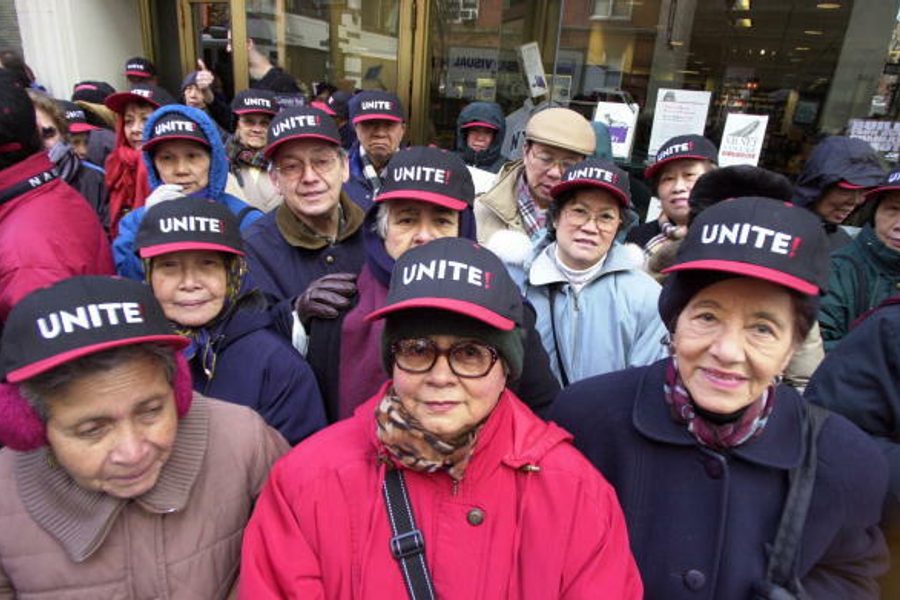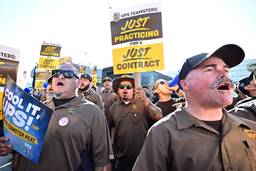
No one who cares about the future of the American labor can disagree with the conclusion of Jane McAlevey’s new book, No Shortcuts: Organizing for Power in the New Gilded Age.
She calls for a “bottom-up organizing model, one that encourages and equips workers to resist the multifaceted assault on their interests inside and outside the workplace.” That sort of organizing is necessary for unions to survive and thrive, McAlevey writes, outlining both her book’s greatest virtue and its biggest problem. She is right that organizing needs to be what the labor movement does, but wrong in her analysis of why unions aren’t doing enough of it now.
McAlevey’s first book, Raising Expectations (and Raising Hell), was built around her personal experiences as a union organizer. It had an intense, you-are-there quality that is rare and made the book a must-read. Drawing from her work with the Service Employees International Union in Las Vegas in the mid-2000s, McAlevey argued that the U.S. labor movement had abandoned “deep organizing” for “shallow mobilizing,” and that recovering what McAlevey calls “whole worker organizing” is key to a revived labor movement.
No Shortcuts aims to extend that argument. As in Raising Expectations, McAlevey tells compelling stories of workers in action through a series of well-chosen case studies of recent labor movement successes, half-successes and failures. Throughout, she shows that when organizing efforts embrace worker involvement, leader identification and training, and take the time to build connections from within the workplace to the broader community, success is possible. Similarly, when unions bypass or ignore workers to cut deals directly with bosses or politicians, neither unions nor workers win.
If such a formulation seems trite or cliché, that’s because it is. Almost no one in the labor movement would disagree. The critical question, then, is this: If we all agree on what needs to be done, why aren’t we doing it?
McAlevey wants her readers to believe that many unions have made a deliberate decision to eschew deep organizing, a “strategic choice by key leaders of New Labor to move away from workers and the workplace.” (She defines “New Labor” as unions that have embraced new kinds of organizing over the past 20 years, putting in that basket some 75 percent of unionized workers in the country.) She implies that unions have, and had, complete freedom to choose one approach or the other, and chose wrongly.
McAlevey finds the roots of this decision in the work of legendary community organizer Saul Alinsky who, she contends, fatally misunderstood his experiences organizing in Chicago in the years around World War II. Well known for his 1971 book Rules for Radicals: A Practical Primer for Realistic Radicals, Alinsky created a model where organizers, not workers, are the movers of change, and workers are little more than pawns to be manipulated in the service of a larger vision.
McAlevey’s critique of Alinsky is intriguing and fairly persuasive. However, she then attempts to claim that Alinsky’s philosophy and methodology were consciously adopted by New Labor as a deliberate turn away from the deep organizing used by the Congress of Industrial Organizations during the 1930s. This claim involves gargantuan and unjustifiable leaps of logic. Not only is she unable to demonstrate that labor has a specific and coherent theory of change inspired by Alinsky, McAlevey fails to demonstrate that it has a specific or coherent theory of change at all. The alternative view — that unions primarily operate based on contingency, chance and circumstance, rather than the principled application of an overarching theory — is effectively ignored by McAlevey. I, for one, with 20 years of experience in “organized” labor, can only wish that unions are half as capable of the philosophical coherence attributed to them in No Shortcuts.
What’s most puzzling about McAlevey’s argument is that her book’s case studies prove the exact opposite point than the one she is trying to make. Organizing is a messy, muddy, complex process. There is no neat dividing line between mobilizing and organizing. Success involves skill, luck, timing, persistence and adequate resources. What works in one place doesn’t always work in another, and the same union can and will do things very differently depending on a host of factors. The examples in No Shortcuts demonstrate this with devastating clarity.
Her case studies — nursing home organizing by SEIU, the Chicago Teachers Union insurgency that led to its 2012 strike, the 2008 Smithfield plant victory in North Carolina and the worker center/union Make the Road New York — are satisfyingly diverse. The stories are, by turns, empowering, frustrating and fascinating. They make the book worth reading even though McAlevey draws the wrong lessons from them. They show that gifted, talented and committed union leaders have very different views on how unions should do what unions do, and that the most successful unions are the ones willing to toss aside dogma and adapt to changing circumstances quickly.
I share McAlevey’s belief that unions can and should do better, and that they need to involve workers in all aspects of a campaign. But their failures aren’t the consequence of a deeply-ingrained, all-encompassing flawed philosophy. Nor is the solution, as McAlevey argues, the wholesale adoption of a different model of organizing. Trying to find an ideal “model” is a distraction. Organizing is hard. It is expensive, risky and even in ideal circumstances fails a lot. The lesson of the stories in McAlevey’s new book is that the best organizing isn’t done by adhering to an abstract organizing model, but by properly assessing where you are, where you need to go and how to get there.

I hope you found this article important. Before you leave, I want to ask you to consider supporting our work with a donation. In These Times needs readers like you to help sustain our mission. We don’t depend on—or want—corporate advertising or deep-pocketed billionaires to fund our journalism. We’re supported by you, the reader, so we can focus on covering the issues that matter most to the progressive movement without fear or compromise.
Our work isn’t hidden behind a paywall because of people like you who support our journalism. We want to keep it that way. If you value the work we do and the movements we cover, please consider donating to In These Times.





